It is common knowledge that many plants are highly poisonous when ingested. There are also many poisonous plants in the wilderness that you don’t want to make contact with. How many can you recognize that are poisonous to touch? Here we’ll show you how to identify the common ones you’ll likely encounter when hiking in the United States that you should not touch. Know how to identify the common ones, and you’ll avoid any aggravating rashes.
How to Recognize Plants that are Poisonous to Touch
Poison Ivy (Toxicodendron radicans)
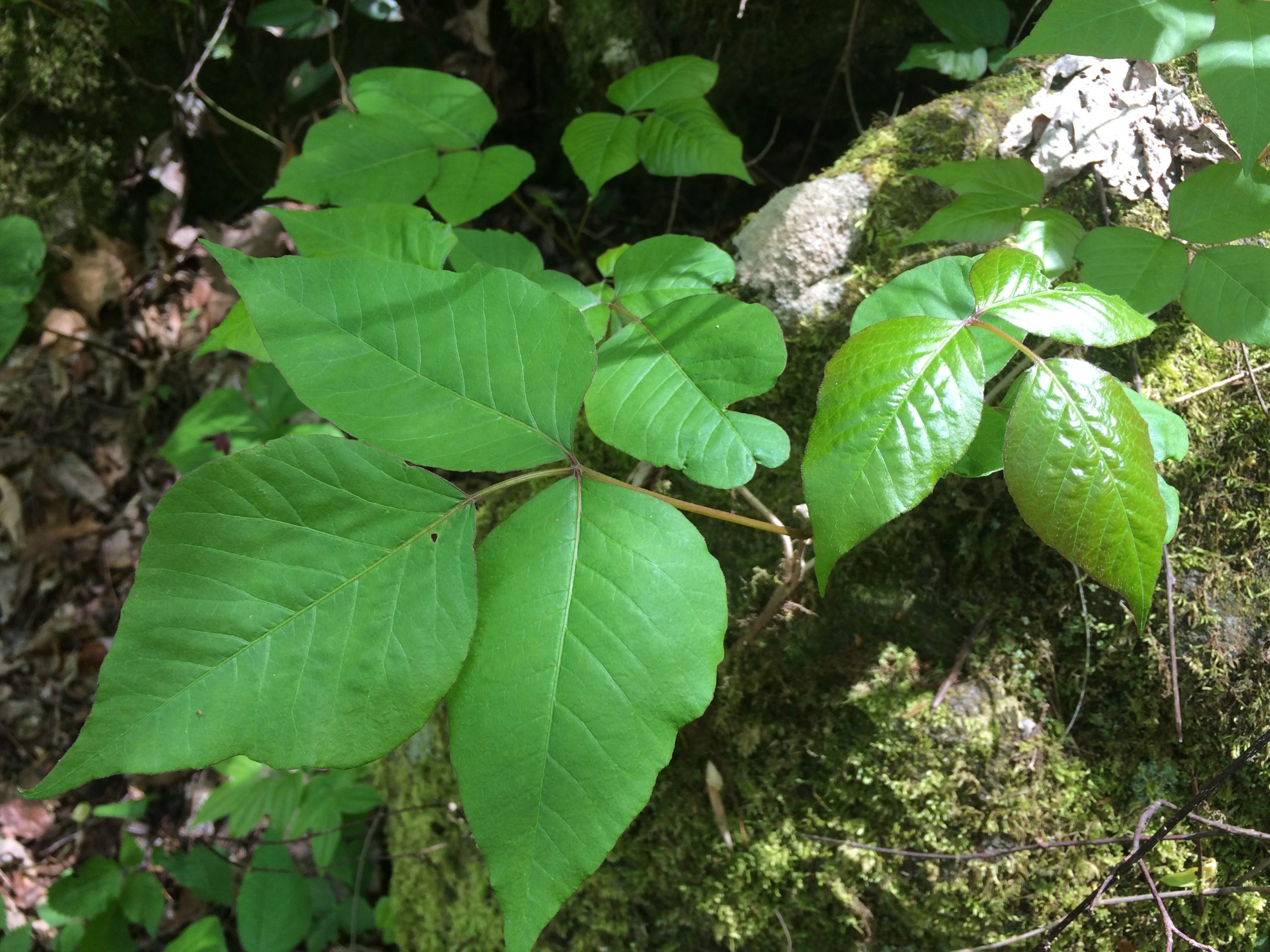
Poison Ivy is the most common poisonous plant you’ll encounter and causes an itchy rash for most people who touch it. The rash is caused by urushiol, a clear liquid compound found in the sap. Despite its common name as an ivy, poison ivy is not a true ivy because it does not always climb. It is variable in its appearance and habitat. It is found growing as a shrub, a trailing vine along the ground, or climbing fences, posts, and trees.
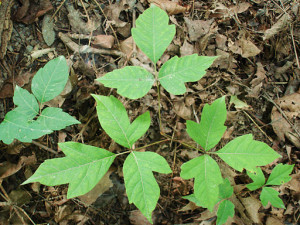
Identify by: A woody stem (no thorns) with clusters of 3 leaves consisting of 2 opposing leaflets and 1 larger terminal leaf. Each group of three leaflets grows on its stem, which connects to the main vine. Leaflets may have a notch. Flowers are yellow-green (appearing May – July) in clusters near the round, waxy white berries.
Found: Nearly everywhere, especially along fences, trail posts, and stone walls in North America, Asia, Bermuda, & Bahamas.
Caution: 80% of the human population is allergic to urushiol, the oil excreted by poison ivy and poison oak. It is not poisonous to most wildlife. Animals often consume the leaves and birds consume the berries. The berries are astaple food for birds during the winter months. The birds spread poison ivy after excreting the seeds contained in the berries.
Symptoms: Red rash, inflammation, spreading blisters and scabs 4 to 24 hours after contact. Can cause temporary blindness if oil gets into the eyes. Never touch any portion of the plant, even in the winter when it appears dormant. The leaves of the plant do not have to be intact for you to get a rash.
Poison Oak (Toxicodendron diversilobum – Western U.S; Toxicodendron pubescen – Eastern U.S)
Poison Oak is a low-growing shrub (up to 3 ft tall) with compound leaves containing 3 leaflets. Unlike poison ivy, the leaflets are lobed with rounded edges, which give it the appearance of an oak tree leaf. The “oak” in the common name refers to the fact that the leaves resemble those of the white oak tree. Coincidentally, poison oak tends to climb on the trunk of Oak trees. Leaves are brighter on the top side and slightly hairy underneath. Flowers are yellow-green (appearing May – June) in clusters near the hard waxy berries (berries turn white during autumn).
Found: Most common form on the western U.S. coast (diversilobum), also called ‘Pacific Poison Oak,’ is found growing at sea level at elevations up to 5,000 feet in dry woodlands. The eastern form, also known as ‘Atlantic Poison Oak’ grows in dry sandy soils, predominately in the southeastern states.
Poison Sumac (Toxicodendron vernix)
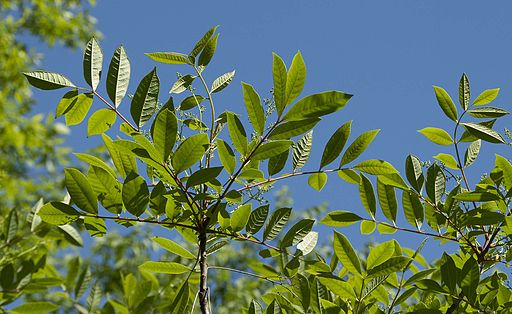
Sumac is a small tree (up to 25 feet) with a few wide spreading branches. It likes water and is usually found in the eastern U.S. in wet soils in and around swamps and marshes. The compound leaves are pinnate, containing an odd number of leaflets, usually between 7-13 in number. The leaflets are 2 to 4 inches long with a smooth edge and pointed tip. Because it is a tall, sumac poisoning tends to affect the face and head. The flower and fruit from poison sumac are very similar to those of poison ivy and poison oak.
Found: Southern U.S. near swamps, especially common along the Mississippi River.
Poison Ivy Relatives
You are less likely to encounter the following plants unless you where they flourish. Unlike poison ivy, they require more specific growing conditions. They are no less dangerous to touch, and the effect of poisoning is very similar to that of poison ivy. Some of the nastiest species, such as poisonwood, are found in South Florida in sandy coastal areas and tropical hammocks.
Poison Wood (Metopium toxiferum)
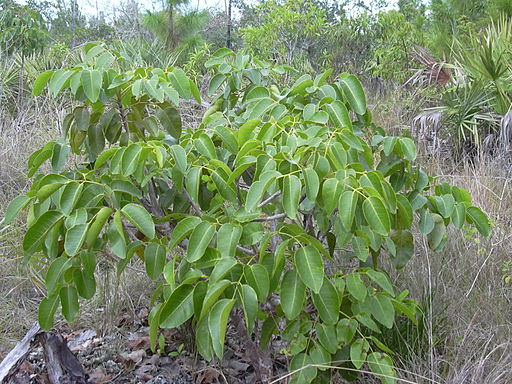
Poisonwood is an evergreen tree that can reach up to 35 feet high. It has a short trunk with stout arching limbs and drooping branches that form a spreading, rounded crown. It is often smaller (as a shrub) in pine forests and larger (as a tree) in the hammocks. You can easily recognize it by the drooping pinnately compound glossy green leaves that are outlined with a yellow border. There are commonly 5 leaflets that are 6 to 10 inches long and alternately arranged. The tree bark is reddish-brown and has dark, oily patches from the gummy sap. The bark is a lighter color when it is a shrub.
Avoid walking under poisonwood trees while it is raining or after recent rain. The sap is very sticky, and if you get any on your skin, it must be washed off with soap and water. Water alone will not dissolve the sap. You can use an alcohol-based hand sanitizer in the absence of soap. Note: Poisonwood is related to the Manchineel tree, one of the most poisonous trees in the world. The Machineel tree is rare in the U.S.; a few exist in southern Florida.
Found: Most common in South Florida near the Florida Keys and Everglades National Park.
Other Urushiol Plants
Many other plants in the Sumac family contain urushiols, such as Mango tree, Rengas tree, Lacquer tree, the shell of the cashew nut, and Ginkgo biloba. While these are less common or nonexistent in the U.S., you should know how to identify these plants if you are planning to hike in an area where they are known to grow.
Stinging nettle is another plant that can cause contact dermatitis. While the reaction is mild compared to the plants above, it can still produce blisters.
Stinging Nettle (Urtica dioica)
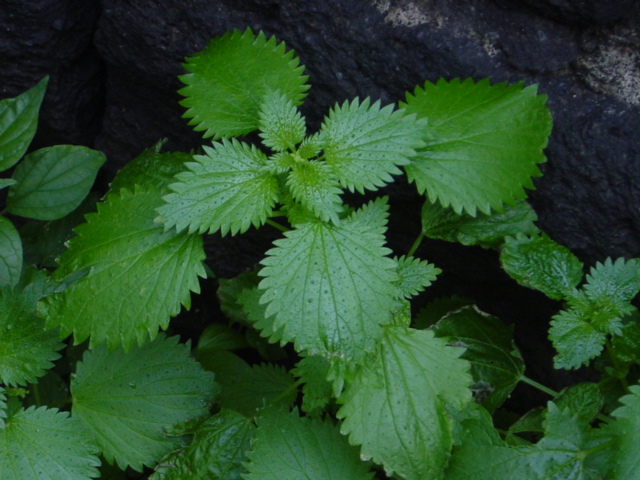
If you ever hike in the southeastern part of the U.S., you’ll almost certainly encounter stinging nettle, a perennial unbranched upright shrub, 2 – 4 feet tall with needle-covered leaves. It produces small stunning whitish flowers in the summer. If you touch the leaves, the stinging hairs will get into your skin and create a burning sensation and itching. Some people also develop blisters.
Stinging nettle has a long history of medicinal and culinary use. The young leaves offer excellent nutrition and can be eaten if cooked (cooking inactivates the harmful effect). If you can positively identify it, try eating the young leaves of stinging nettle on your next thru-hike. Pick the smaller leaves (less than 6″ tall) and use gloves when picking and handling them. The leaves have a flavor similar to spinach and are high in calcium, iron, vitamin A & vitamin C.
Found: Moist and shady areas across the U.S.
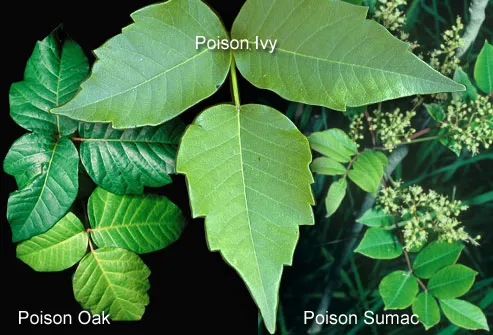
Points to Know
- “Leaves of three, let it be” is a common way to remember what poison ivy & poison oak look like; however, there are many other 3 leaflet plants which are harmless; if you blindly followed this, you could miss out on plants with edible berries, such as strawberries and raspberries!
- The edges of the poisonous leaf can be smooth or contain teeth, and the top surface may be glossy or dull.
- Leaflets can change color during the season – may be green in spring, yellow-green in summer, and red in fall.
- Clusters of white berries develop during early summer, turning gray later in the season. The berries are smooth and hard to the touch.
- Don’t “punish” a poisonous plant by burning it. The urushiol oil vaporizes and is toxic to the lungs if inhaled.
Factors to consider
- Individuals have different tolerances when coming into contact with poisonous plants. Poison Ivy is poisonous to some while harmless to others.
- The amount of contact time that is required to cause an allergic reaction can vary per individual or type of plant.
- Keep an eye on your dog when hiking. A few minutes of your dog walking off the trail to sniff around is all it takes for him/her to brush up against one of these poisonous plants. Dogs are not allergic to the oil, and you won’t realize it until later when you snuggle with (or pet) your dog.
- These plants rarely grow at higher elevations (above 5,000′).
- You can not spread a rash by scratching it. The rash is spread only by the urushiol resin, which is not contained in the fluid within your blister. However, the oil can get on your fingers and spread that way. That is why you should wash your hands first and foremost.
- Be careful when you do scratch the rash or blisters. Bacteria from under your fingernails can get into the blisters and cause a secondary bacterial infection, which can cause bigger problems on the trail. Keep your fingernails cut low if you have no discipline.
Related Posts:
Article sources:
Plant identification: http://edis.ifas.ufl.edu/ep220
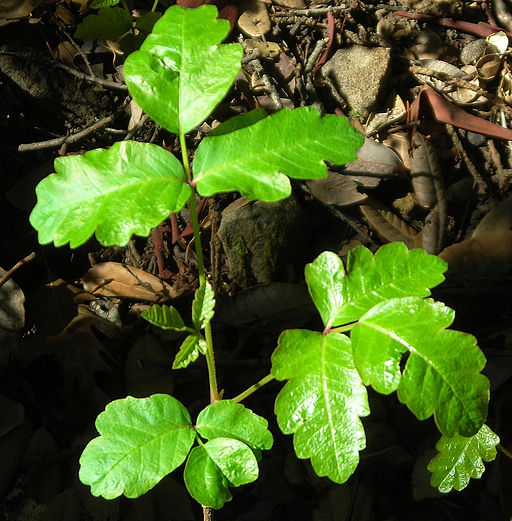
17 thoughts on “Don’t touch these poisonous plants!”
A good thing to remember with poison ivy is that the leaflets are toothed, lobed or smooth-edged and they grow alternately on the vine; in other words, one leaf on the left of the stem, the next one on the right, then left and so on.
Hi, I was cutting down a throned bush and got scraped. I now have raised welts on my legs that itch a lot and will not go away. Any suggestions?
Thanks
Dan
Sorry to hear that, Dan! You can try soaking your leg in an epson salt solution to dry it out, or make a vinegar compress to temporarily soothe the itching. For the vinegar solution, mix 1 part vinegar to 3 parts icy cold water in a container. Dampen a cloth with the solution and apply it to the rash. For commercial products, try Mean Green Power Scrub, or Tecnu Oak-n-Ivy.
Update 7/15/15: After coming back from a recent paddling trip, I developed a bad rash from Poison Sumac. I decided to try Zanfel. It definitely stops the itching and redness, however the rash does not disappear as quickly as advertised.
How do you get rid of sumac?
If you use zanfel exactly as the directions say the reaction will stop progressing and begin to heal-healing time will depend on severity of the rash and each individual’s skin. We’ve been dealing with poison ivy, oak and sumac on our woodsy property for years and it is the best treatment so far!
I encountered poison oak in my yard. Did not know what it was. It was a horrible two week of hell experience. I broke out so badly all over my lower torso.
The zanfel expensive but helps with the itching and allows the rash to go away keep scrubbing with it exactly how the directions suggest!
Thank you all for these suggestions. I got a rash on my forehead, chin and in between some fingers! Yikes.itch, itch itch. I will try the Cancel. I used Tecnu last year and it did help, but those blisters go away at their own speed.
Watch out for those mangos!!! My neighbor told me to help myself so i piled my arms high with several, getting the sticky sap all over my arms and torso.
I am still suffering almost 2 weeks later.
I could not figure out what I had gotten into until reading this site!!
Thanks!
Ok so there is a part in this article that says that you cannot spread poison ivy by scratching it. This I do not find to be true. I feel like mine does spread from the liquid contained in the blister. Or maybe that part of the article needs to be reworded because mine has always found a way to spread by touching it to other parts of the body or just spreading further from original spot on my body as time goes by even if it is not specifically from the liquid in the blisters.
I was in Yucatan Mexico and backed into a Poisonwood tree aka chechem. One of the Mayans gave me some leaves from the Chaka tree and said it was the cure. I finely diced the chaka leaves and added it to some lotion. I cleaned the leg that I knew was touched, then applied the chaka cream and covered it with plastic with electrical tape to protect clothing, furniture, and bedding. The next day the hot spots on that leg were gone, but I could feel some hot spots on the other leg. I was told that chaka only worked if applied immediately, but figured I should try it. It cleared up!. Not a single blister!
Hi my name is Randy just moved to northern Fl. I have a 3′ green plant like bush growing wild along my fence with thorns and leaves shaped like maple leaves..all green.. any idea what it might be?…. will send a pic if needed thank you Randy
i would like to know the answer to that also. growing up in Ms. i’ve cut and burned a lot of it,
Mangoes are problem if they are fresh. The urushiol breaks down over time so often mangoes bought in store up north are not a problem.
Thank You for the explanation of great information about the removing of poisonous form the stems of trees ,if you are interested to remove this kind of insects reaction,Then you must follow all the instructions are mentioned in this pos and start providing a pure water to all the trees ,which is helpful for you to remove the stress of trees during the growing of trees after reading and understanding the most important key points mentioned in the awesome article especially ” White fringetree disease “
I used to get stung by nettles regularly as a child, we called it stingweed, and it hurt bad, but I don’t recall getting an itchy rash afterwards. So, I had no idea it had urushiol in it. I am very allergic to poison ivy, have had steroid treatment for it and have used everything under the sun to get through the symptoms. Something not mentioned here is Mango. I once got horrible rash all over my face after eating a mango out of the skin like orange slices. I found out later that mango trees are related to sumac and contain urushiol as well.